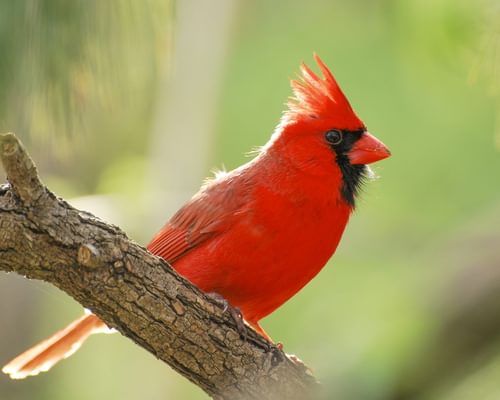The Northern Cardinal is widely distributed throughout Florida and the eastern half of the United States. They are not specific to one type of habitat. Cardinals occur in a variety of ecosystems, as long as the area offers enough vegetative cover for the bird to live and nest safely.
Cardinals are found in nearly every Florida ecosystem, from coastal intertidal zones to swamps and forest edges. As they are not very shy birds, they also frequent suburban areas where bird feeders are prevalent.
If you love observing cardinals in your backyard or on walks, you will be happy to hear that these birds are year-round residents in Florida. They remain in their territories all season long, offering you ample opportunities to observe their behavior.
Read on to learn more about Northern cardinals in the great state of Florida!

Northern Cardinals can be found in Florida all yer round
Are there Cardinals in Florida?
Cardinals are one of the most common songbirds present throughout Florida. These birds live anywhere forests or thickets provide enough cover. They can be found deep in the woods, in marsh or grassland habitats, and even in your backyard.
Florida also has two subspecies of cardinal. One - C. cardinalis ssp. floridanus - is specific only to the state. The second - C. cardinalis ssp. cardinalis - is found west of the Apalachicola River.
Cardinal populations have increased throughout the US in the past 40+ years. However, for reasons not yet fully understood, cardinals have decreased in numbers in peninsular Florida.

Closeup of a male Northern Cardinal perched on a branch, Florida
Where do Cardinals live in Florida?
The Northern cardinal and cardinal subspecies are found all over the state of Florida. They exist in a variety of Floridian habitats, including forest edges, thickets in second-growth forests, marshes, grasslands with dense shrub cover, riparian and mangrove forests, and hedgerows in agricultural areas.
Regardless of the ecosystem, cardinals prefer nesting in areas with dense foliage. Such areas offer coverage and protection for nest sites and the cardinals themselves.

Northern Cardinal on the ground in Lower Keys, Florida
How rare is it to see a Cardinal in Florida?
It is not at all rare to see cardinals in Florida. They inhabit a variety of habitats throughout the state and are one of the most common backyard birds.
The only exception is the rare yellow northern cardinal. This color variation within the species is uncommon and only observed in the state a few times a year.

Yellow Northern Cardinal in Florida

Rare yellow colored male Northern Cardinal - a genetic mutation, pictured in Gainsville, Florida
Best places to see Cardinals in Florida?
The best places to see cardinals in Florida are natural areas that provide the habitat this species requires. Forest edges, thickets, marshes, and even mangrove forests in coastal intertidal zones are all areas where cardinals reside.
Florida boasts many state parks and wildlife reserves with trail systems that take you through excellent cardinal habitat.
Your backyard can also be a great place to see cardinals. These birds love visiting feeders in yards that provide ample forage and the coverage these birds need to feel safe. We will discuss attracting cardinals to your yard in more detail later on.

Female Northern Cardinal visiting a feeder, Florida
Do Cardinals live in Florida all year?
Cardinals are year-round residents in Florida, meaning they can be found throughout the state every season. Even in the northernmost reaches of their habitat these birds are not considered migratory. They may move nest sites and change locations throughout their territory, but they generally remain in the same area their entire lives.
Are there Cardinals in Florida in Winter?
Cardinals remain in Florida throughout the winter. They breed, nest, and winter within the same range every year. In fact, cardinals are common bird feeder visitors in the winter months.
As previously discussed, this species is non-migratory.

Fluffy male Northern Cardinal, perched on a tree in Naples, Florida
Do Cardinals nest in Florida?
Cardinals have a long nesting season in Florida, likely due to the state's mild winters. Females will lay their eggs any time between February and September. A nesting pair generally has two to four broods per season.
Northern cardinals construct their nests in the fork of a branch, 1 to 15 feet off the ground. Nest sites are hidden amongst the dense foliage of trees, shrubs, or tangled vines to offer protection from predators and the elements.
This species does not reuse previous years' nests. Mated pairs choose a new nest site within their range and rebuild year-after-year.

Cardinal using a bird bath
How to attract Cardinals in Florida?
Cardinals frequent backyard bird feeders in Florida year-round. The best way to attract these birds and keep them coming back is to offer the food sources and habitat features they like.
First of all, cardinals are typically ground feeders, so offering seeds directly on the ground or on a low platform feeder is preferable. Once you have found the perfect setup, fill your feeders with their favorite seeds - sunflower, safflower, and suet.
Additionally, cardinals feel safest with some overhead protection from vegetation. To provide this, place your feeder on a low branch within dense foliage offering protection from above. Setting up a birdbath nearby is also a great final touch these birds will appreciate.

